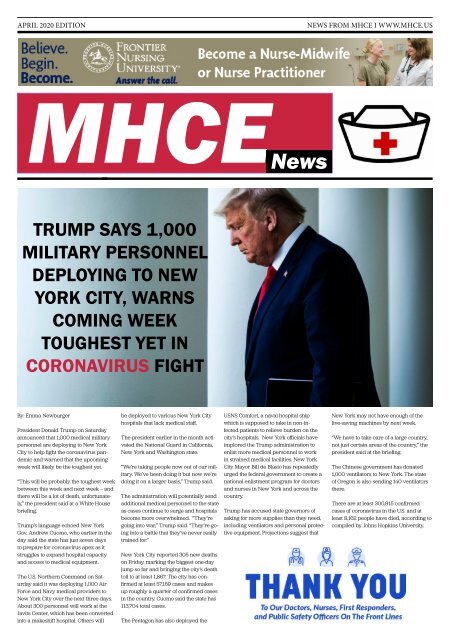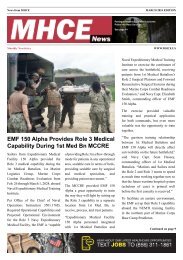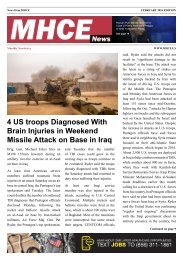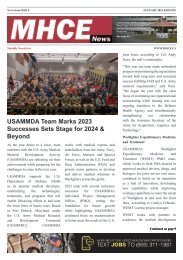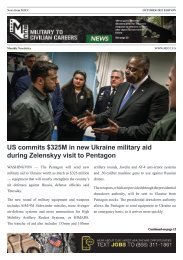MHCE April 2020
MHCE April 2020
MHCE April 2020
Create successful ePaper yourself
Turn your PDF publications into a flip-book with our unique Google optimized e-Paper software.
APRIL <strong>2020</strong> EDITION<br />
NEWS FROM <strong>MHCE</strong> I WWW.<strong>MHCE</strong>.US<br />
<strong>MHCE</strong> News<br />
TRUMP SAYS 1,000<br />
MILITARY PERSONNEL<br />
DEPLOYING TO NEW<br />
YORK CITY, WARNS<br />
COMING WEEK<br />
TOUGHEST YET IN<br />
CORONAVIRUS FIGHT<br />
By: Emma Newburger<br />
President Donald Trump on Saturday<br />
announced that 1,000 medical military<br />
personnel are deploying to New York<br />
City to help fight the coronavirus pandemic<br />
and warned that the upcoming<br />
week will likely be the toughest yet.<br />
“This will be probably the toughest week<br />
between this week and next week -- and<br />
there will be a lot of death, unfortunately,”<br />
the president said at a White House<br />
briefing.<br />
Trump’s language echoed New York<br />
Gov. Andrew Cuomo, who earlier in the<br />
day said the state has just seven days<br />
to prepare for coronavirus apex as it<br />
struggles to expand hospital capacity<br />
and access to medical equipment.<br />
The U.S. Northern Command on Saturday<br />
said it was deploying 1,000 Air<br />
Force and Navy medical providers to<br />
New York City over the next three days.<br />
About 300 personnel will work at the<br />
Javits Center, which has been converted<br />
into a makeshift hospital. Others will<br />
be deployed to various New York City<br />
hospitals that lack medical staff.<br />
The president earlier in the month activated<br />
the National Guard in California,<br />
New York and Washington state.<br />
“We’re taking people now out of our military.<br />
We’ve been doing it but now we’re<br />
doing it on a larger basis,” Trump said.<br />
The administration will potentially send<br />
additional medical personnel to the state<br />
as cases continue to surge and hospitals<br />
become more overwhelmed. “They’re<br />
going into war,” Trump said. “They’re going<br />
into a battle that they’ve never really<br />
trained for.”<br />
New York City reported 305 new deaths<br />
on Friday, marking the biggest one-day<br />
jump so far and bringing the city’s death<br />
toll to at least 1,867. The city has confirmed<br />
at least 57,159 cases and makes<br />
up roughly a quarter of confirmed cases<br />
in the country. Cuomo said the state has<br />
113,704 total cases.<br />
The Pentagon has also deployed the<br />
USNS Comfort, a naval hospital ship<br />
which is supposed to take in non-infected<br />
patients to relieve burden on the<br />
city’s hospitals. New York officials have<br />
implored the Trump administration to<br />
enlist more medical personnel to work<br />
in strained medical facilities. New York<br />
City Mayor Bill de Blasio has repeatedly<br />
urged the federal government to create a<br />
national enlistment program for doctors<br />
and nurses in New York and across the<br />
country.<br />
Trump has accused state governors of<br />
asking for more supplies than they need,<br />
including ventilators and personal protective<br />
equipment. Projections suggest that<br />
New York may not have enough of the<br />
live-saving machines by next week.<br />
“We have to take care of a large country,<br />
not just certain areas of the country,” the<br />
president said at the briefing.<br />
The Chinese government has donated<br />
1,000 ventilators to New York. The state<br />
of Oregon is also sending 140 ventilators<br />
there.<br />
There are at least 300,915 confirmed<br />
cases of coronavirus in the U.S. and at<br />
least 8,162 people have died, according to<br />
compiled by Johns Hopkins University.
2<br />
<strong>MHCE</strong> News<br />
APRIL <strong>2020</strong> EDITION<br />
Weathering COVID-19:<br />
Physical Resilance<br />
PORTLAND AIR GUARD STATION, OR,<br />
UNITED STATES<br />
Story by Tech. Sgt. Steph Sawyer<br />
142nd Fighter Wing Public Affairs<br />
PORTLAND, OREGON<br />
As most of the world is practicing<br />
social distancing, and in some cases,<br />
self-quarantine, many Americans are<br />
spending much of their days at home,<br />
working and living outside of their<br />
typical routines.<br />
On Monday, March 23, <strong>2020</strong>, Oregon<br />
Governor Kate Brown issued a ‘stay<br />
at home’ order in an effort to further<br />
limit the transmission of COVID-19.<br />
Earlier this month, the U.S. Air Force<br />
announced that physical fitness testing<br />
would be suspended entirely until<br />
late June.<br />
Though our lives have been interrupted<br />
by COVID-19, it’s important<br />
to remember that as members of<br />
the Oregon Air National Guard and<br />
the U.S. Air Force, we are required<br />
to maintain a certain level of physical<br />
fitness in order to carry out our<br />
duties safely and efficiently when<br />
we are called upon to do so. 142nd<br />
Fighter Wing Command Chief, Chief<br />
Master Sgt. Brent Cavanais stresses<br />
the importance of physical readiness<br />
at this time.<br />
“The challenges we’re facing today<br />
put readiness at risk if we aren’t<br />
vigilant about mitigating them,” said<br />
Cavanais. “In terms of fitness, it is the<br />
consummate challenge of balancing<br />
taking care of our Airmen and our<br />
mission. Ultimately, fitness comes<br />
down to an individual responsibility.<br />
We absolutely care about the health<br />
and wellbeing of our force, and fit<br />
Airmen are critical to our combat<br />
readiness.”<br />
While maintaining physical fitness<br />
is necessary for physical readiness<br />
and wellness, it also stands to benefit<br />
your mental health. Making physical<br />
exercise part of your daily routine<br />
helps to reduce feelings of stress and<br />
anxiety, lifts overall mood, and improves<br />
quality of sleep.<br />
Because the benefits of physical<br />
exercise spill over into our mental<br />
health, it’s a powerful tool to help us<br />
cope in times of stress. 1st Lt. Kyle<br />
Osborne, an anti-terrorism officer in<br />
the 142nd Security Forces Squadron,<br />
and fitness program manager for the<br />
142nd Fighter Wing, can attest to the<br />
positive impact of regular physical<br />
exercise.<br />
“When I was active duty, I had a lot<br />
of sleeping problems. I just couldn’t<br />
sleep, couldn’t shut my mind off...just<br />
couldn’t relax,” said Osborne. “I started<br />
focusing on more of a fitness regimen.<br />
So I worked out two hours before<br />
bedtime.” Osborne said that working<br />
out before bed drastically improved<br />
the quality of his sleep.<br />
Though our resources are somewhat<br />
limited because of the current circumstances,<br />
there are things we can do to<br />
stay active while practicing social distancing.<br />
Activities like going for a walk<br />
or jog around the block, turning on<br />
some music and dancing, or challenging<br />
a loved one to a lightsaber duel<br />
are all excellent ways of incorporating<br />
physical exercise into daily life.<br />
Master Sgt. Justin Mills, a munitions<br />
accountability systems officer in the<br />
142nd Aircraft Maintenance Squadron,<br />
weighed in on a recent post on<br />
the 142nd Fighter Wing’s Instagram<br />
account. ‘Since my gyms are closed,<br />
I’m running, hiking, biking with my<br />
fam and alone,” says Mills. “Bonus!<br />
This also works for mental fitness!”<br />
Anything you can do to get your body<br />
moving throughout the day is going to<br />
benefit your physical and mental wellbeing.Keep<br />
in mind that If you choose<br />
to exercise outdoors, remember to be<br />
cognizant of other people and allow<br />
for six feet of space between yourself<br />
and others.<br />
If outdoor activities aren’t your thing<br />
or if you can’t get outdoors, there are<br />
plenty of resources for indoor exercise<br />
at your fingertips if you have an<br />
internet connection.<br />
YouTube is an excellent platform for<br />
guided workout videos. Osborne suggests<br />
searching for “travel workout of<br />
the day” or “hotel workout of the day.”<br />
These are workouts specifically designed<br />
to be performed in confined<br />
spaces, working around beds and other<br />
pieces of furniture. Other genres of<br />
guided workouts include yoga, Pilates,<br />
dance, and martial arts.<br />
The thing to keep in mind as you work<br />
to establish an at-home fitness routine<br />
is to keep it simple. Utilize the resources<br />
you have. You can use water jugs,<br />
canned goods, or detergent bottles for<br />
resistance and weight training, use<br />
your staircase in your workout routine,<br />
take your dog for a walk or run, or<br />
play with your kids. Most of all, have<br />
fun!<br />
WANT TO TAKE OUT<br />
AN AD?<br />
SEND AN EMAIL TO<br />
CONTACT@<strong>MHCE</strong>.US<br />
FOR MORE INFO
WWW.<strong>MHCE</strong>.US <strong>MHCE</strong> News 3<br />
Trump Orders VA<br />
to Stop Withholding<br />
Money from Veterans<br />
By Jim Absher<br />
In reaction to the national emergency<br />
caused by the novel coronavirus,<br />
President Donald Trump<br />
has directed the Department of<br />
Veterans Affairs (VA) to stop withholding<br />
payments or benefits from<br />
veterans who have a debt with the<br />
agency.<br />
In his <strong>April</strong> 2 news conference<br />
detailing the nation’s response to<br />
the COVID-19 pandemic, Trump<br />
announced that he had directed<br />
VA Secretary Robert Wilkie to suspend<br />
collections from veterans.<br />
Veterans Win with Ace<br />
Join us in continuing our legacy of<br />
making Ace “the helpful place.”<br />
During the news conference, the<br />
president stated, “We take very<br />
good care of our veterans. At my<br />
direction, Secretary Wilkie will<br />
use any authority at his disposal to<br />
extend deadlines for benefits and<br />
suspend debt collections.”<br />
While the exact timeline and process<br />
of the debt suspension isn’t<br />
known at this time, the VA’s Debt<br />
Management Center (DMC) states<br />
on its website that it is currently<br />
offering temporary debt relief on<br />
a case-by-case basis. The website<br />
states, “If you are affected by the<br />
COVID-19 (CORONAVIRUS), have a<br />
[Veterans Benefits Administration]<br />
benefit debt and need temporary<br />
financial relief, please contact DMC<br />
at 1-800-827-0648 to request assistance.”<br />
As a result of the president’s statement,<br />
you shouldn’t have to call<br />
the VA’s DMC to have your debt<br />
suspended. However, it is probably<br />
advisable to take the initiative and<br />
request suspension of debt collections,<br />
just in case.<br />
Trump’s statement also sounds like<br />
it directs the department to stop<br />
collection of any debts related to VA<br />
medical treatment; however, that remains<br />
to be seen.<br />
If you owe the VA money for overpaid<br />
benefits, your debt will not be<br />
excused, just suspended. You will<br />
still have to pay it back eventually.<br />
The exact timeline of the suspension<br />
is not known at this time, but<br />
the announcement will most likely<br />
stop any garnishments, tax levies<br />
and court-ordered collections for<br />
the foreseeable future.<br />
Normally, if you owe the VA money,<br />
it will either work with you to get it<br />
back or force you to comply. Measures<br />
could include adding interest<br />
and late fees to your debt after 30<br />
days; withholding other VA benefits<br />
after 90 days; garnishing your wages;<br />
withholding other federal benefits;<br />
and referring you to a collection<br />
bureau after 120 days.<br />
Veterans Education Success, a veterans<br />
advocacy group, applauded<br />
the announcement on its Twitter<br />
account, stating, “We’re cautiously<br />
optimistic of this announcement as<br />
it’s been a priority of ours during<br />
this time of a national crisis in our<br />
country.”<br />
The group testified to Congress in<br />
September 2019 that VA debt collection<br />
affects one in four GI Bill<br />
recipients and often results in the<br />
department withholding disability<br />
payments and tax refunds or garnishing<br />
wages to satisfy debts.
4<br />
<strong>MHCE</strong> News<br />
APRIL <strong>2020</strong> EDITION
WWW.<strong>MHCE</strong>.US <strong>MHCE</strong> News 5<br />
How to Highlight Military Jobs<br />
in MBA Applications<br />
Any MBA applicant with military experience should recognize that the discipline and grit cultivated in the military is useful in business<br />
By Ilana Kowarski, Reporter<br />
U.S. News & World Report<br />
MBA HOPEFULS WITH military experience<br />
should know that graduate business<br />
schooladmissions officers are often thrilled<br />
to receive applications from military veterans<br />
and active-duty military personnel.<br />
MBA<br />
admissions experts say MBA candidates<br />
from the military tend to have unique work<br />
experience and an interesting outlook on life<br />
that is distinct from that of their nonmilitary<br />
peers, so admitting these candidates enhances<br />
the diversity of an MBA class.<br />
Alex McKelvie, associate dean for undergraduate<br />
and master’s education with Syracuse<br />
University’s Whitman School of Management,<br />
describes a military background<br />
as a “major plus” in the MBA admissions<br />
process.<br />
We are looking for students who have leadership<br />
experience and can work as part of a<br />
team,” McKelvie wrote in an email. “These<br />
are fundamental skills for business and being<br />
able to demonstrate that in previous military<br />
experience, such as having worked as an<br />
officer, is important.”<br />
[Read: How MBA Applicants With Military<br />
Backgrounds Can Fund Their Education.]<br />
McKelvie says military MBA applicants do<br />
face a unique obstacle to success, though,<br />
because in the military, people are trained to<br />
be humble and not to brag, but it’s important<br />
for these applicants to fully and clearly describe<br />
their credentials in their MBA applications.<br />
“In many cases, they are underselling<br />
themselves and their accomplishments<br />
– they need to be a bit more braggadocios,”<br />
McKelvie says.<br />
MBA degree recipients who served in the<br />
military before business school say that any<br />
MBA applicant with military experience<br />
should recognize that the discipline and grit<br />
cultivated in the military is useful in business.<br />
“A lot of military people are thrust into very<br />
challenging situations, war or not, at a very<br />
young age. And a lot’s expected of you, and<br />
the standards are high,” says René Bruer, a<br />
Marine Corps veteran and co-CEO of Tallahassee,<br />
Florida-based financial advising firm,<br />
Smith Bruer Advisors.<br />
Bruer, who suffered an injury while he was<br />
in the military, says he included information<br />
about the adversity he had faced as a result<br />
of that injury in his MBA application to California<br />
Lutheran University.
6<br />
<strong>MHCE</strong> News<br />
APRIL <strong>2020</strong> EDITION<br />
WOMEN’S HISTORY<br />
MONTH: ARMY<br />
FALLS CHURCH, VA,<br />
UNITED STATES<br />
Story by Ronald Wolf<br />
U.S. Army Medical<br />
Command<br />
March is Women’s History<br />
Month. In addition,<br />
the Department of Defense<br />
is commemorating<br />
the 75th anniversary of<br />
the end of World War II,<br />
one the great historical<br />
events of American history.<br />
Within the U.S. military,<br />
World War II made<br />
the nurse an indispensable<br />
aspect of battlefield<br />
medical care.<br />
One of the infrequently<br />
recognized sacrifices of<br />
Army nurses was the<br />
time spent as prisoners<br />
of war in the Philippines.<br />
During the siege and<br />
occupation of the Philippines,<br />
Army Nurses<br />
showed their grit and<br />
courage. Some 60 nurses<br />
ended up as POWs.<br />
Throughout 1941, the<br />
United States had deployed<br />
additional troops<br />
in the Philippines to be<br />
prepared for potential<br />
threats. The number of<br />
Army nurses stationed<br />
on the islands grew to<br />
more than 100. Most of<br />
the nurses worked at<br />
Sternberg General Hospital<br />
in Manila or seven<br />
miles away at Fort McKinley.<br />
About five nurses<br />
worked on the island of<br />
Corregidor.<br />
The Japanese attacked<br />
the Philippines on Dec.<br />
8, 1941. The result was<br />
a large number of casualties,<br />
and the small staff<br />
was swamped. By late<br />
December, the nurses<br />
received orders to evacuate<br />
to Manila. Japanese<br />
forces had landed on<br />
the island of Luzon and<br />
closed in on Manila. All<br />
of the nurses stationed<br />
outside of Manila were<br />
taken prisoner by the<br />
Japanese.<br />
Gen. Douglas MacArthur<br />
ordered the nurses<br />
to the island of Corregidor.<br />
He planned to<br />
hold Corregidor and the<br />
Bataan Peninsula and<br />
wait for reinforcements.<br />
Nurses on Corregidor<br />
and Bataan helped set<br />
up two emergency hospitals<br />
for U.S. and Filipino<br />
forces—General Hospitals<br />
1 and 2.<br />
More than 1,200 battle<br />
casualties requiring major<br />
surgery — head, chest,<br />
and abdominal wounds<br />
and amputations — were<br />
admitted to General Hospital<br />
1 within a month.<br />
General Hospital 2 was<br />
on a river out in the open,<br />
with no tents or buildings,<br />
under a canopy of trees.<br />
Here, the nurses worked<br />
for several months into<br />
1942. The Japanese<br />
bombed General Hospital<br />
1 on March 29 killing or<br />
wounding more than 100<br />
patients. The nurses carried<br />
on. With each passing<br />
week, the number of patients<br />
increased, supplies<br />
decreased, and patients<br />
became more susceptible<br />
to malaria, dysentery, and<br />
other tropical diseases.<br />
By the end of March 1942,<br />
hospitals that were barely<br />
set up to handle 1,000<br />
patients had more than<br />
5,000 each.<br />
In early <strong>April</strong> 1942, the<br />
Army evacuated its nurses<br />
to Malinta Tunnel Hospital<br />
on Corregidor. Even<br />
though U.S. and Filipino<br />
forces on Bataan surrendered,<br />
Japanese pilots<br />
continued to bomb Bataan<br />
for weeks following<br />
the surrender. One nurse<br />
described the Malinta<br />
Tunnel Hospital as “pretty<br />
ghastly.” The bombs sent<br />
shock waves through the<br />
ground, filling the tunnel<br />
with dust and dirt. The<br />
nurses never knew when<br />
they would be plunged<br />
into total darkness. The<br />
crowded tunnel hospital<br />
grew from 500 beds to<br />
1,000.A handful of nurses<br />
were able to evacuate<br />
to Australia. In late<br />
<strong>April</strong> 1942, 20 nurses left<br />
Corregidor on two Navy<br />
planes. One reached Australia,<br />
but the second had<br />
to land on Mindanao<br />
Lake; all aboard were<br />
taken prisoner. In early<br />
May, one submarine<br />
picked up 10 Army<br />
nurses and one Navy<br />
nurse and took them to<br />
Australia. The Army on<br />
Corregidor surrendered<br />
several days later; 55<br />
Army nurses were still<br />
at Malinta Hospital caring<br />
for the wounded.<br />
In July, the Japanese<br />
took the nurses to Santo<br />
Tomas Internment<br />
Camp in Manila where<br />
they joined the 10 nurses<br />
whose plane had<br />
made a forced landing<br />
on Mindanao Lake. The<br />
67 nurses remained<br />
POWs until U.S. troops<br />
liberated them in February<br />
1945.<br />
This story tells the<br />
strength and resilience<br />
of the Army nurses in<br />
the Philippines.<br />
It was their grit, determination,<br />
intelligence, and<br />
commitment that proved<br />
that women can step up<br />
and do the job — no matter<br />
how dangerous or<br />
difficult that job may be.<br />
As the war continued,<br />
shortages of manpower<br />
had to be supplemented<br />
by woman-power<br />
everywhere. Very soon,<br />
women were ferrying<br />
bombers across the Atlantic,<br />
manning lathes<br />
and welding equipment<br />
in defense plants, and<br />
manning the home front.<br />
Today, women in the<br />
military handle virtually<br />
all missions — doing<br />
every job, every day,<br />
everywhere.<br />
It was the Army Nurse<br />
Corps leading the way<br />
for women to fill every<br />
job today.
WWW.<strong>MHCE</strong>.US <strong>MHCE</strong> News 7<br />
U.S. MILITARY SEEKS MORE FUNDING<br />
FOR PACIFIC REGION AFTER PANDEMIC<br />
By Julian E. Barnes<br />
WASHINGTON — United States<br />
military officials have outlined a<br />
spending request to bolster deterrence<br />
against China after the<br />
coronavirus pandemic ebbs, a<br />
sign of how national security leaders<br />
are already studying ways to<br />
shore up the country’s standing<br />
in the Asia-Pacific region once<br />
the outbreak ends. A report from<br />
the U.S. Indo-Pacific Command,<br />
delivered to Congress last week,<br />
calls for $20.1 billion in additional<br />
spending between 2021 and<br />
2026. The funds would be spent<br />
on new radar warning systems<br />
and cruise missiles, and would<br />
also pay for more exercises with<br />
allies, deployments of additional<br />
forces and new intelligence-sharing<br />
centers. The efforts would<br />
help improve the U.S. military’s<br />
ability to deter the People’s Liberation<br />
Army.<br />
The request, which was first reported<br />
by Defense News, shows<br />
that many in the military believe<br />
tensions between the United<br />
States and China are likely to grow<br />
amid the pandemic. President<br />
Trump and President Xi Jinping<br />
of China cut an uneasy peace in<br />
late March, each promising to dial<br />
back accusations of who was at<br />
fault for the spread of the virus,<br />
which is believed to have originated<br />
late last year at a market<br />
in Wuhan. But U.S. intelligence<br />
officials have said they expect tensions<br />
to flare again, and China to<br />
restart its efforts to deflect blame<br />
for the virus and spread disinformation<br />
about the United States’<br />
role in its origin.<br />
While Congress commissioned<br />
the report from the Indo-Pacific<br />
Command before the coronavirus<br />
plunged the world economy<br />
into chaos and heightened tensions<br />
between the United States<br />
and China, current and former<br />
national security officials said the<br />
spending request was more relevant<br />
now.<br />
China is sure to use the aftermath<br />
of the virus to try to strengthen its<br />
hold on the Pacific region, according<br />
to lawmakers. But the United<br />
States will also have an opportunity<br />
to shore up its traditional allies.<br />
As hot spots shift in the U.S., Washington<br />
State shows how one place<br />
that is rebounding can help others.<br />
The U.S. is undercounting the<br />
number of people who have died<br />
in the pandemic, experts say.<br />
The pandemic threatens to upend<br />
the status quo around the<br />
world, particularly in Asia, where<br />
the infections began, said Senator<br />
Josh Hawley, Republican of<br />
Missouri, who has advocated increased<br />
military funding for the<br />
Pacific region.<br />
“China understands that the<br />
global pandemic is an inflection<br />
point,” Mr. Hawley said. “They are<br />
trying to turn this to their advantage.<br />
Make no mistake, they are<br />
still pursuing their global strategic<br />
ambitions. The need for us to<br />
laser focus on China’s economic<br />
and military ambitions is going to<br />
be more urgent once we beat this<br />
pandemic, not less.”<br />
Some members of Congress and<br />
military strategists have long argued<br />
that the Pentagon needed<br />
to fund a deterrence initiative in<br />
Asia, akin to measures in Europe<br />
after Russia annexed Crimea<br />
in 2014 and began its war with<br />
Ukraine. The European funding<br />
paid for new military exercises,<br />
the deployment of forces to the<br />
Baltic States and Poland, and upgrades<br />
to logistic facilities, like<br />
ports.<br />
Among the projects proposed in<br />
the report is a series of new intelligence-sharing<br />
centers. While<br />
the United States has close intelligence<br />
ties with New Zealand and<br />
Australia, its partnerships with<br />
allies in Southeast Asia are more<br />
anemic. The new money would<br />
create a counterterrorism center,<br />
an Oceania fusion center and other<br />
intelligence facilities.<br />
The spending plan also calls for<br />
the United States to build up its<br />
missile defenses in Guam and<br />
other parts of the so-called second<br />
island chain, which is farther<br />
east than the first island chain. It<br />
would fund radar installations in<br />
Hawaii, Palau and other locations<br />
to better track hypersonic missile<br />
threats..<br />
The proposal would fund more<br />
offensive weaponry such as Navy<br />
Tomahawk missiles. Intermediate-range<br />
land-based missiles<br />
were once banned by international<br />
treaties, but the Trump administration<br />
withdrew last year from<br />
the Intermediate-Range Nuclear<br />
Forces Treaty, in part to counter<br />
a growing threat from China. The<br />
move allows the United States to<br />
defend Taiwan and other parts of<br />
the first island chain.<br />
“In order to change the calculus<br />
of our adversary, we must deny<br />
them the ability to control the<br />
air and sea around the first island<br />
chain,” the report says. “U.S.<br />
forces must be capable of fighting<br />
in highly contested environments<br />
against technologically<br />
advanced opponents.”<br />
Members of Congress and military<br />
strategists have argued that<br />
the threat of missiles from China<br />
has shown that the United States<br />
needs to better disperse its<br />
forces in Asia, which are largely<br />
concentrated in South Korea<br />
and Japan.<br />
Representative Mike Gallagher,<br />
Republican of Wisconsin, said in<br />
an interview that Iran’s missile<br />
strikes on American troops at<br />
bases in Iraq show the potential<br />
vulnerability of forces fixed in a<br />
single location.<br />
The United States needed to better<br />
defend its outposts in the Pacific,<br />
like Guam, with new radar<br />
and other military equipment,<br />
he said.<br />
“This should provide a wake-up<br />
call for all Americans to increase<br />
defense investments in the Indo-Pacific,”<br />
Mr. Gallagher said.<br />
“Slogans that the Indo-Pacific is<br />
the Pentagon’s top priority will<br />
remain just that — slogans — until<br />
the Pentagon puts resources behind<br />
the command.”<br />
The economic destruction from<br />
the coronavirus pandemic is<br />
likely to put pressure on the<br />
defense budget. That will make<br />
creating a new pool of funding<br />
to build up the U.S. presence in<br />
Asia all the more urgent, said<br />
Eric Sayers, a former congressional<br />
staff member and a senior<br />
adviser to the Indo-Pacific<br />
Command.<br />
Mr. Sayers, who is now a vice<br />
president at Beacon Global<br />
Strategies, a Washington-based<br />
consultancy, has written about<br />
the need to increase short-term<br />
military spending in the Pacific<br />
given Chinese expansion and<br />
military activity in the region.<br />
“For all the change we should<br />
expect in a post-Covid world,<br />
the shifting military balance in<br />
Asia and the concern it has created<br />
for America’s allies will endure,”<br />
Mr. Sayers said.
8<br />
<strong>MHCE</strong> News<br />
APRIL <strong>2020</strong> EDITION<br />
Why the U.S. Military Stopped<br />
Using Flamethrowers<br />
By Peter Suciu<br />
The idea of using fire as a weapon<br />
likely occurred as soon as the first<br />
human settlement was attacked by<br />
a rival tribe. The problem is that fire<br />
doesn’t know friend from foe and for<br />
eons couldn’t really be controlled.<br />
The earliest known example of a “controlled<br />
burn” directed at an enemy<br />
was the Bzyantine’s “Greek Fire.”<br />
Exactly what ingredients went into the<br />
mixture and how it was projected at an<br />
enemy remains a mystery, but it was<br />
certainly a heated, pressurized liquid<br />
that was delivered by a tube called a<br />
siphōn but it could also be used with<br />
hand-held projectors as well as in early<br />
grenades. It was mostly used to light<br />
enemy ships on fire from a reasonably<br />
safe distance. According to various<br />
sources Greek Fire was invented in<br />
the 7th century and helped the Byzantines<br />
fend off early Muslim assaults.<br />
Why it fell out of use is unknown, but<br />
by the 13th century Greek Fire disappeared<br />
from the battlefield.<br />
It wasn’t until the First World War that<br />
fire was once again harnessed in a<br />
controlled manner. German scientist<br />
Richard Fiedler had developed the<br />
concept of the “Flammenwerfer” in<br />
the years just prior to the conflict, and<br />
his design was small enough that it<br />
could be carried by one man and shot<br />
a stream of flaming oil about 20 yards.<br />
The trenches of the Western Front happened<br />
to be an ideal proving ground<br />
for the then-untested weapon, and the<br />
Germans first employed both the compact<br />
version as well as a larger version<br />
that doubled the range against French<br />
troops outside of Verdun in early 1915.<br />
The weapons were once again used<br />
against the British in the summer of<br />
1915 and this convinced the Germans<br />
to deploy the Flammenwerfer across<br />
all the fronts.<br />
After the end of the war other nations<br />
considered how the flamethrower<br />
could be employed, and both the<br />
Americans and British developed new<br />
models that were fueled with napalm,<br />
a thickened gasoline that burned with<br />
intense heat. The U.S. military used<br />
these to great effect against the Japanese<br />
fortifications including log bunkers<br />
and caves during World War II.<br />
The biggest disadvantage of the flamethrower<br />
was that a soldier had to<br />
wear a heavy tank on his back, which<br />
restricted movement and made that<br />
individual a very large target. While<br />
the fuel might not ignite from being<br />
hit by an enemy round, the escaping<br />
gas, once mixed with oxygen, would<br />
be quite flammable! The other issue was<br />
that flamethrowers really only offered<br />
about twenty to thirty seconds of use—<br />
after which it was just a heavy piece of<br />
equipment to carry.<br />
Despite these issues, the U.S. Department<br />
of Defense clearly saw some potential advantages<br />
that the flamethrower offered<br />
and created various man-portable and<br />
vehicle-mounted incendiary weapons.<br />
This included the M-202 Flame Assault<br />
Shoulder Weapon (FLASH), which was a<br />
rocket-based system that could hit a target<br />
five times further away than the older<br />
World War II era devices.<br />
In Vietnam various flamethrowers were<br />
also seen as a valuable close combat<br />
weapon—one that could demoralize enemy<br />
troops and reduce positions that have<br />
otherwise resisted other forms of attack.<br />
However, images of the “Napalm Girl”—<br />
the 1972 Pulitzer Prize-winning photo<br />
of a naked nine-year-old girl fleeing her<br />
village following a napalm attack—helped<br />
turn public opinion against the use of<br />
such weapons.<br />
There are no specific international bans<br />
on the use of flamethrowers; however,<br />
there are the international humanitarian<br />
law (IHL) treaty norms, which specifically<br />
regulate incendiary weapons as found<br />
in the 1980 Protocol III on Prohibitions<br />
or Restrictions on the Use of Incendiary<br />
Weapons to the Convention on Prohibitions<br />
or Restrictions on the Use of Certain<br />
Conventional Weapons (Protocol<br />
III). This would include, “any weapon or<br />
munitions which is primarily designed to<br />
set fire to objects or to cause burn injury<br />
to persons through the action of flame,<br />
heat, or combination thereof, produced<br />
by a chemical reaction of a substance delivered<br />
on the target (emphasis added).”<br />
Whether this would call for a ban on<br />
such weapons is unclear according to<br />
legal experts: “It is uncontroversial that<br />
any use of a flamethrower, be it a proper<br />
incendiary weapon or not, in breach of<br />
those rules on the protection of civilians<br />
would be unlawful. The same would hold<br />
true for any weapon.”<br />
However, in 1978 the DoD issued a directive<br />
effectively retiring flamethrowers<br />
from use in combat.<br />
Perhaps ironically, while automatic<br />
weapons including machine guns, as<br />
well as short barreled rifles/shotguns and<br />
other destructive devices, now all fall under<br />
the National Firearms Act of 1934,<br />
flamethrowers do not. Various commercial<br />
versions that can still shoot fire up to<br />
fifty feet are completely legal in 48 states;<br />
only Maryland bans them outright, while<br />
California considers them “destructive<br />
devices,” but does issue permits for restricted<br />
use such on movies.
WWW.<strong>MHCE</strong>.US <strong>MHCE</strong> News 9<br />
As the Coronavirus (COVID-19) pandemic has unfolded over<br />
the last few weeks, time often feels like it’s slowed to a standstill.<br />
The onslaught of news headlines has made it difficult for the<br />
general public to discern how worried they should really be, and<br />
so the attempts to “flatten the curve” have been uncoordinated<br />
thus far. People have rushed to stockpile food, paper goods, and<br />
masks, swept up in the flurry of making sure they have “enough”.<br />
In the urgency of it all, we’ve forgotten to thank the people at the<br />
center of it all: our courageous nurses.<br />
The nursing profession has long been charged with the noble,<br />
awe-inspiring, messy, and exhausting work of caring for the sick<br />
and suffering. Nurses have the enormous privilege of carrying the<br />
burden of preserving human dignity amid uncertainty. Together<br />
with their physician colleagues and exceptional care teams,<br />
nurses meet and care for people when they’re at their most fragile<br />
– bringing hope to what, in some cases, may be the worst day of<br />
their lives.<br />
may put yourself and your loved ones at risk. During this unprecedented<br />
period of time marked with angst and anxiety – what a few have referred<br />
to as our generation’s “World War” – thank you for being the helpers and<br />
heroes we look to. It is never easy work, and few will understand why we<br />
do it – but we charge on, ready to fight another day.<br />
In awe and gratitude,<br />
A fellow nurse<br />
Lucia Huang, RN<br />
Market Manager<br />
Nurses hold a beautiful contradiction: To be able to walk alongside<br />
another person during their moments of vulnerability requires<br />
a special type of selflessness and strength. Most days, this<br />
profession feels like a calling – it is the most essential, impactful,<br />
rewarding type of work. But there’s a reason why healthcare delivery<br />
is often referred to in terms of war metaphors. Nurses are<br />
“in the trenches” and “on the front lines of care.” They “go into<br />
battle” and if they’re lucky, they “emerge unscathed” – but more<br />
often not, nurses carry emotional and physical “battle scars”.<br />
I’d like to thank the nurses who run towards the line of danger as<br />
the rest of us retreat into the safety of our homes. This was not a<br />
battle you signed up for, but it is one for which you’re taking up<br />
arms and fighting regardless. You’ve done the mental calculus<br />
and against human nature, chosen selflessness over self-preservation<br />
– not just today in the war against the invisible enemy that<br />
is COVID-19, but every time you step into your scrubs. Thank<br />
you for choosing to serve and care for those that might be afflicted<br />
with the virus, even though the mere act of caring for them
10<br />
<strong>MHCE</strong> News<br />
APRIL <strong>2020</strong> EDITION<br />
US TROOPS WILL<br />
BE DIRECTED TO<br />
WEAR FACE MASKS,<br />
SECDEF SAYS<br />
WANT TO TAKE<br />
OUT AN AD?<br />
SEND AN EMAIL<br />
TO CONTACT@<br />
<strong>MHCE</strong>.US<br />
U.S. Navy Sailors with 2nd Medical Battalion, 2nd Marine Logistics Group, prescreen<br />
Marines and sailors for the coronavirus disease after returning from an exercise<br />
overseas on Marine Corps Air Station Cherry Point, North Carolina, . (U.S.<br />
Marine Corps photo/Rachel K. Young-Porter)<br />
Defense Secretary Mark Esper said Sunday that<br />
he was directing the use of face masks by the military<br />
worldwide to combat the spread of coronavirus.<br />
“We’re going to move toward face coverings”<br />
across the force, Esper said on ABC-TV’s “This<br />
Week.”<br />
He gave no immediate details, but said a directive<br />
would be issued later Sunday on when, where<br />
and how face masks, and what types, should be<br />
used to guard against coronavirus.<br />
Esper’s announcement followed recommendations<br />
Friday from the White House coronavirus<br />
task force and the Centers for Disease Control<br />
and Prevention that all Americans should consider<br />
the voluntary use of face coverings when in<br />
public.<br />
“We want to take every measure to protect our<br />
troops,” Esper said. But he again cautioned that<br />
the military can’t always follow the medical<br />
guidelines on social distancing and other measures<br />
in the close quarters of ships, submarines,<br />
bombers and tanks.<br />
Esper has previously left it up to individual commanders<br />
to decide on how best to implement the<br />
guidelines in their areas of responsibility.<br />
The upcoming directive on face masks in the military<br />
could also be expected to apply to dependents,<br />
civilian DoD personnel and contractors.<br />
As of Saturday, the Defense Department reported<br />
more than 1,600 cases of coronavirus among<br />
service members, civilians, dependents and contractors<br />
and six deaths: one service member, two<br />
civilians, one dependent and two contractors.<br />
The vast majority of the positive cases in DoD<br />
were considered moderate or mild, but 74 had<br />
been hospitalized as of Saturday, DoD said.<br />
Esper’s action comes as the number of coronavirus-positive<br />
cases and deaths in the U.S. and<br />
worldwide continued to surge.<br />
In the U.S. there were more than 312,000 cases<br />
and 8,500 deaths as of Sunday morning, the<br />
Johns Hopkins Coronavirus Resource Center reported.<br />
Worldwide, there were more than 1,225,000 cases<br />
and 66,500 deaths, Johns Hopkins said.<br />
-- Richard Sisk can be reached at richard.sisk@<br />
military.com.
WWW.<strong>MHCE</strong>.US <strong>MHCE</strong> News 11<br />
HELP SLOW<br />
THE SPREAD!
12<br />
<strong>MHCE</strong> News<br />
APRIL <strong>2020</strong> EDITION<br />
After 50 Years, the Army and Marine Corps Are<br />
Closing In on Dumping Brass-Cased Ammo<br />
Military.com | By Matthew Cox<br />
After more than 50 years of failed<br />
attempts, the U.S. military may be on<br />
the verge of ending its love affair with<br />
brass-cased ammunition, something<br />
that predates the Spanish-American<br />
War.<br />
Traditional brass has dominated<br />
military small-arms ammunition<br />
since U.S. troops stormed up San<br />
Juan Hill, Cuba, in 1898. The robust<br />
material performs well in the violent,<br />
super-heated space of weapon<br />
chambers during firing, but its sheer<br />
weight has always been a problem<br />
for infantrymen and logisticians alike.<br />
Advancements in body armor, communications<br />
equipment and other<br />
tactical gear have weighed down U.S.<br />
combat troops in the Army and Marine<br />
Corps, pushing individual loads<br />
well past 100 pounds and degrading<br />
service members’ physical performance,<br />
U.S. military studies have<br />
shown.<br />
Both services have launched multiple<br />
efforts to lighten the weapons and<br />
equipment grunts carried while fighting<br />
in Iraq and Afghanistan, but ammunition<br />
weight has always been an<br />
Achilles’ heel for these efforts.<br />
Related: Inside the Army’s Quest for a<br />
Revolutionary New Bullet<br />
“We have not gotten lighter in the last<br />
20 years,” Lt. Gen. Eric Smith, commander<br />
of Marine Corps Combat<br />
Development Command, told House<br />
Armed Services Committee members<br />
at a March 5 hearing. “We have slowed<br />
the rate of weight increase, which is<br />
unacceptable.”<br />
Early attempts at lighter, plastic-cased<br />
cartridge designs failed to meet military<br />
standards, but recent technical<br />
advances by a few bold companies<br />
have prompted the Army and Marine<br />
Corps to launch new efforts to test polymer-cased<br />
ammunition for infantry<br />
units.<br />
In early January, the Corps announced<br />
it plans to invest up to $10 million in polymer-cased<br />
.50 caliber ammo to test<br />
in the “Ma Deuce” M2 machine gun, a<br />
potent weapon used by both Army and<br />
Marine mounted combat units.<br />
The Army’s role in the Joint Lightweight<br />
Ammunition Integrated Product Team<br />
is to find a lightweight-cased replacement<br />
for brass-cased 7.62x51mm,<br />
the caliber used in Army and Marine<br />
M240 machine guns and some sniper<br />
weapons.<br />
“The ultimate goal is to replace brasscased<br />
ammunition for all 7.62mm ammunition<br />
in the Army,” Becky Leonard,<br />
spokeswoman for the Joint Program<br />
CONTINUE ON PAGE 13
WWW.<strong>MHCE</strong>.US <strong>MHCE</strong> News 13<br />
CONTINUED<br />
Executive Office for Armaments & Ammunition<br />
at Picatinny Arsenal, New Jersey,<br />
told Military.com.<br />
The Army’s Next Generation Squad<br />
Weapon Effort<br />
The Army is also evaluating lightweight-cased<br />
6.8mm ammunition for<br />
its Next Generation Squad Weapon<br />
(NGSW) effort, which is designed to<br />
replace the M4A1 carbine and M249<br />
Squad Automatic Weapon with more<br />
potent weapons that significantly lighten<br />
ammunition weight.<br />
Two of the three firms competing in<br />
the final phase of the program -- Textron<br />
Systems and General Dynamics<br />
Ordnance and Tactical Systems Inc.<br />
-- use polymer-cased technology for<br />
their lightweight 6.8mm cartridges.<br />
The third, Sig Sauer Inc., uses a more<br />
traditional brass-case design with a<br />
stainless-steel base to save weight in its<br />
NGSW prototypes.<br />
The Army hopes to select a final design<br />
for both weapons from a single company<br />
in the first quarter of 2022 and<br />
begin fielding them to an infantry brigade<br />
combat team in the first quarter of<br />
2023, modernization officials have said.<br />
True Velocity Ammunition LLC’s line of<br />
polymer cased ammunition.<br />
True Velocity Ammunition LLC shows<br />
off its line of polymer cased ammunition<br />
at SHOT Show <strong>2020</strong>. (Military.com/Matthew<br />
Cox)<br />
But this is not the first time the Army<br />
has launched futuristic infantry weapon<br />
programs involving lightweight ammunition;<br />
previous attempts resulted in<br />
failure.<br />
In 1951, the service developed the Special<br />
Purpose Individual Weapon, which<br />
fired plastic-cased 12-gauge rounds<br />
filled with multiple flechettes, or darts, in<br />
an attempt to increase the probability of<br />
hitting enemy targets.<br />
The Advanced Combat Rifle program,<br />
launched in 1986, pursued a similar<br />
goal, with several of the prototypes featuring<br />
plastic-cased ammunition.<br />
The Army took a renewed interest in<br />
lightweight ammunition after 9/11, when<br />
combat troops began to struggle under<br />
heavy combat loads in Iraq and Afghanistan.<br />
“Soldiers on combat patrols in Afghanistan<br />
typically carry 92 to 105 pounds of<br />
mission-essential equipment ... this overload<br />
causes fatigue, heat stress, injury<br />
and performance degradation for soldiers,”<br />
according to a 2005 report by the<br />
Armament Research, Development and<br />
Engineering Center (ARDEC) at Picatinny<br />
Arsenal on “Alternative Cartridge<br />
Case Material and Design.”<br />
“Despite years of research and development,<br />
the Army’s weapons and equipment<br />
[are] still too heavy to allow foot<br />
soldiers to maneuver safely under fire,” it<br />
states. “The only way to fully realize lightweight<br />
concepts is to look at novel ways<br />
of designing the system, such as allowing<br />
the use of lightweight polymer composites<br />
for cartridge case applications.”<br />
Perhaps the most successful weapons<br />
programs involving polymer-cased ammunition<br />
were launched in 2004 under<br />
the Army’s Lightweight Small Arms<br />
Technology (LSAT), which resulted in<br />
successful tests of a special case-telescoped<br />
(CT) ammunition in lightweight<br />
machine gun prototypes chambered for<br />
5.56mm and 7.62mm, and a rifle prototype<br />
chambered 6.5mm CT ammo.<br />
Textron has incorporated the CT technology<br />
developed in LSAT into the<br />
6.8mm cartridge it designed for its Next<br />
Generation Squad Weapon prototypes.<br />
The technology relies completely on a<br />
plastic case to hold the propellant and<br />
the projectile.<br />
The Move to Polymer-Cased Ammo<br />
While the commercial ammunition market<br />
may stick with brass, Wayne Prender,<br />
senior vice president for Applied<br />
Technologies & Advanced Programs<br />
at Textron, told Military.com that he<br />
is convinced that the U.S. military will<br />
eventually have to move toward polymer-cased<br />
ammo.<br />
“Weight is a significant factor for a military<br />
application, more so than a commercial<br />
application or sporting application,”<br />
Prender said. “You are carrying<br />
significantly more with significantly less<br />
support structure. Ounces may not matter<br />
if you are going out for a hunt, but<br />
ounces matter when ... your life depends<br />
on it.<br />
“That is why weight is such a significant<br />
factor in a military application and why<br />
we endeavored on it.”<br />
True Velocity Ammunition LLC began<br />
designing polymer-cased ammunition<br />
for the military in 2010 and now makes<br />
the 6.8mm cartridge for General Dynamics’<br />
NGSW prototype weapons.<br />
“It’s not a new concept. The U.S. Army<br />
has had a lightweight ammunition requirement<br />
for going on 40 years now.<br />
It’s just [that] nobody has been able to<br />
bring a viable solution to the table,” said<br />
Pat Hogan, chief marketing officer for<br />
True Velocity. “I think that the technology<br />
has arrived. ... we have proven that it is<br />
viable.”<br />
Both Textron and True Velocity maintain<br />
that their polymer-cased ammo designs<br />
offer about a 30 percent weight savings<br />
over brass ammunition, but also bring<br />
increased performance.<br />
In 2005, polymer-cased technology suffered<br />
from too many flaws to perform<br />
adequately under harsh combat conditions,<br />
according to findings in the ARDEC<br />
report.<br />
Since then, companies like Textron and<br />
True Velocity have learned how to solve<br />
the problems highlighted in the report,<br />
such as “cracks on the case mouth, neck,<br />
body and base” and “insufficient high<br />
temperature resistance.”<br />
“Brass is a conductor of heat, and our<br />
composite case is an insulator,” Hogan<br />
said. “Brass conducts the heat during the<br />
ballistic event; the brass superheats and<br />
then transfers that heat to the chamber<br />
of the weapon, whereas polymer insulates<br />
the chamber from that heat.”<br />
Excessive heat buildup can cause ammo<br />
to cook off or explode in the weapon, a<br />
problem True Velocity’s case technology<br />
has licked, he said.<br />
“Anecdotally, we have run cook-off tests<br />
through some of the belt-fed platforms<br />
and, in order to get the gun even hot<br />
enough to be in a position where you<br />
could even have a cook off, we have to<br />
run brass ammo through a gun to get<br />
it hot enough where you can really test<br />
our ability to withstand cook-offs,” Hogan<br />
said.
14<br />
<strong>MHCE</strong> News<br />
APRIL <strong>2020</strong> EDITION<br />
WANT TO<br />
TAKE OUT A<br />
AD?<br />
SEND AN<br />
EMAIL TO<br />
CONTACT@<br />
<strong>MHCE</strong>.US<br />
FOR MORE<br />
INFO.
15<br />
<strong>MHCE</strong> News<br />
APRIL <strong>2020</strong> EDITION<br />
Hawaii National Guard Airmen Assist<br />
in Distribution of Key Medical Supplies<br />
During COVID-19 Response<br />
HONOLULU, HI, UNITED STATES<br />
Story by Tech. Sgt. Andrew Jackson<br />
State of Hawaii, Department of Defense,<br />
Public Affairs Office<br />
HONOLULU, HI- Hawaii Air National<br />
Guard members from Medical Detachment<br />
1 provided logistical support this<br />
week with personal protective equipment<br />
(PPE) and maintenance of valuable<br />
medical equipment at the Hawaii<br />
Healthcare Emergency Management<br />
Coalition facilities.<br />
The PPE that the Guardsmen inventoried<br />
and prepared for pick-up, will then<br />
be distributed to multiple Hawaii medical<br />
facilities. These facilities are facing<br />
a shortage of this specialized equipment during<br />
the COVID-19 pandemic.<br />
The Hawaii Healthcare Emergency Management<br />
Coalition is a statewide, federally-qualified,<br />
all-hazards comprehensive emergency<br />
management program whose mission is to<br />
sustain and maintain essential and critical<br />
healthcare system services statewide during<br />
a major emergency or disaster.<br />
Along with logistics and organizing distribution,<br />
Guard members also took inventory of<br />
the medical supplies on-hand.<br />
The Hawaii National Guard is continuing to<br />
support the state’s response to COVID-19 with<br />
over 100 Soldiers and Airmen on State Active<br />
Duty (SAD).
16<br />
<strong>MHCE</strong> News<br />
APRIL <strong>2020</strong> EDITION


